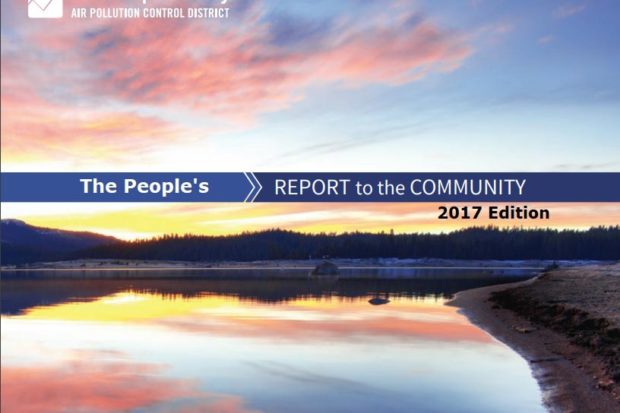
By Tom Frantz
For the past 10 years, the San Joaquin Valley Air Pollution Control District (air district) has issued an annual report to Valley residents regarding its past activities, recent air pollution levels and future plans. That report seems to be missing, or really late, this year, so what follows will be The People’s Report to the Community.
The year 2017 saw business as usual for most big polluters in the Valley. No significant reductions in air pollution were realized, nor were any new rules imposed on polluters. Also, many waivers were routinely granted by the air district for various businesses to bypass their pollution control devices if proven necessary to maintain profits. Guardian Industries, a polluting glass factory in Kingsburg, is one example.
The air district gave many tons of emission reduction credits to polluters for retiring old, inefficient pieces of equipment that were on their way to the scrapyard. Businesses that closed for economic reasons also received these credits even as new businesses took their place, keeping pollution levels the same. One example is the cotton gins that were replaced by almond hullers due to changes in cropping.
Several new developments, such as distribution centers, were illegally allowed to bypass the air quality mitigations required by the Indirect Source Rule (ISR) because they came in under pre-ISR planning by cities. The air district looks the other way in these cases unless they are challenged in court.
The air district allowed more open agricultural burning last year than any time in the previous 10 years because a couple of unsustainable and polluting biomass plants were shut down (hooray!). The air district felt sorry for farmers who would, alternatively, have to do the right thing and recycle their biomass back into their soil if they couldn’t just light a match.
The air district continued to spend millions of dollars in 2017 paying people to install dirty, polluting wood-burning devices in their homes under the pretext these devices were cleaner than the old wood stoves or fireplaces they were replacing. The district then allowed these same people to burn wood in these new polluting devices on many days when the air quality was above current health standards. Fireplace and stove dealers rejoiced at this fortunate gold mine that keeps falling into their lap year after year.
Not one farmer was forced in 2017 to convert a dirty old diesel irrigation pump to a clean electric pump or retire a polluting old tractor for a cleaner model. Instead, millions of dollars were offered as bribes to encourage farmers to make the conversion if they felt like it.
Oil field operators in 2017 were encouraged by the air district, as in past years, to flare off natural gas whenever it was too expensive for them to collect, clean and deliver the gas to a distributor. The air district claims this flaring is better than just venting the gas to the air. People that breathe said the cost of their poor health from this pollution should have been considered in the economic formula.
The air district was partially successful in lobbying Congress to gut the Clean Air Act in 2017, thanks to the support from all local Valley Congressional representatives. The air district wanted sanctions on polluting businesses removed. These are imposed when the Valley fails to meet Clean Air Act standards by prescribed deadlines (the current situation). It also wanted bad air days removed from data showing air quality levels in the Valley. It claimed those bad air days should be considered exceptional events. The House passed the bill as written by the air district. It awaits Senate action in 2018.
The air district successfully delayed, in 2017, development of a mandated plan to clean up fine particulate matter in the Valley. It hopes to have a plan that might work by the end of 2018 (or 2019) but say that it will contain no major new requirements for polluting businesses. It claims these polluters have done enough so they can breathe easy. The rest of us will just have to clean up the air with our lungs.
The air district did clean up some of the bad air at one monitor in Bakersfield by spreading wood chips on the ground nearby. Too bad it didn’t have enough money to do this on the shoulders of all country roads so that residents across the Valley could also have less dust in their air.
Finally, the air quality in the Valley was abysmal in 2017. PM2.5 (fine particulate) levels were a record high during the holiday season. The air district stupidly claimed that was OK because nobody really goes outside for more than a few hours per day. It also said the rest of the year was pretty good, demonstrating the air district was doing a great job.
The air district might still release an annual report for 2017, but you have read the truth here so throw it in the trash if you see one.
*****
Longtime clean air advocate Tom Frantz is a retired math teacher and Kern County almond farmer. A founding member of the Central Valley Air Quality Coalition (CVAQ), he serves on its steering committee and as president of the Association of Irritated Residents. The CVAQ is a partnership of more than 70 community, medical, public health, environmental and environmental justice organizations representing thousands of residents in the San Joaquin Valley unified in their commitment to improving the health of Californians. For more information, visit www.calcleanair.org.
